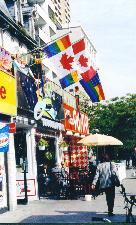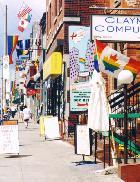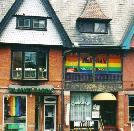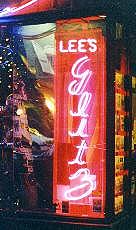|
Promiscuous Affections A Life in The Bar, 1969-2000
1996-1999:
|
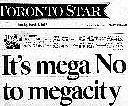
Yeah? So? The citizens' verdict, Toronto Star, Mar 4, 1997. We got Megacity anyway. |
"Efficiency" was ideological ass cover. The Tories' true motive was to submerge the old City, its democracy so messy, in a great suburban wash.
Citizenship
In the city & on the street
In late 1996 -- in the name of "efficiency" and an end to "waste and duplication" -- the new Tory government of Ontario launched the amalgamation of the City of Toronto and its five surrounding suburbs into a single "Megacity."
The six jurisdictions had set up a regional government in 1953: the Municipality of Metropolitan Toronto, meant to to deal with transit, major roads, housing and other matters affecting them together. But each, having become cities in their own right (but for the little Borough of East York), still had its own council, fire department, school board, a host of other services -- and its own distinct brand of local democracy.
For the Tories, too much democracy. The move came on the heels of massive protests against Tory cutbacks, the "Days of Action," backed by Toronto City Council. On Friday, October 25, the city had effectively shut itself down, even public transit stopped, all with the nod of council. Clearly, this was not "efficient."
Studies of other amalgamations had shown they often weren't either. Everyone acknowledged the move would cost money in the short term -- that term lasting some years. It didn't matter: "efficiency" was ideological ass cover. As I wrote to Jane Rule on November 6, the true goal was to "submerge the old City in a great suburban wash."
- There are only about 700,000 in the City proper, 1.5 million in the rest of Metro -- not to mention 2 million more in the great Tory blue belt that surrounds us. That's not part of the plan, but it's from there and beyond that the governing concepts will come, happily executed by those with no grasp of urban realities. What little they do know (from the TV news, no doubt) of this strange, diverse, distinctive place I call home they instinctively fear and hate and hope to suppress.
***
Toronto was not about to take this lying down. The town has a history of citizen activism with a solid record of success. It was citizens coming together who preserved Old City Hall and Union Station; citizens who kept the small residential neighbourhood on the Island from being demolished for a golf course.
Citizens who blocked bulldozers carving the Spadina Expressway, set to rip into the heart of downtown -- and stopped it dead in its tracks. Citizens who saved a stretch of Victoriana on Sherbourne by direct action: "Buildings can't be torn down without a hoarding," Jane Jacobs pointed out -- so they torn down the hoarding, buying a reprieve. Those houses still stand, fronting (and part of) high density, low rise, low cost "infill" housing funded by the city.
The lessons learned in those battles of the late '60s and early '70s had not been lost. Within weeks, Citizens for Local Democracy (C4LD) was born, its guiding light former mayor John Sewell. They met on Monday nights -- each Monday needing a bigger venue: from city council's chamber, to Holy Trinity Church, 600 there; finally, at more than 2,000, overflowing even St James Cathedral.
Not a few of those citizens had habitually voted Conservative -- so far. The Tories quickly convened public hearings at Queen's Park: of the 400 who showed up, 390 opposed amalgamation.
More than 9,000 protesters marched down Yonge Street February 15 -- from where once stood Montgomery's Tavern, site of a key battle in the Rebellion of 1837. Actor Eric Petersen led the way dressed as William Lyon Mackenzie, chief rebel, first mayor of the city. Now it was The Rebellion of 1997.
C4LD pushed the six local governments to hold referenda on the amalgamation. All gladly complied -- and actively backed the "No" forces, who hoped for a two to one victory. The vote came on March 3, 1997, their hopes bettered: 76 percent said "No." In plucky little East York, it was 80.8 percent.
***
It didn't matter. The Tories had said they would ignore the results. They could: cities in Canada are creatures of provincial governments, free to muck with however they wish.
On January 1, 1998 the old City of Toronto was declared dead, entombed in a Megacity of 2.3 million people. It got 57 elected councillors. In December 1999 the province unilaterally cut that to 44. Next year it may be just 22. For the 2.4 million residents of the surrounding Tory Blue Belt, the number is 213.
The name on the tomb does say City of Toronto, the whole thing now the fifth biggest municipal jurisdiction in North America. At last: World Class.
***
In The Rebellion of 1997, biggest civic uprising here since "Stop Spadina" in 1971 (or, one might argue, the bath raid demos of 1981), a potential force was conspicuous by its absence.
In Xtra, February 13, Jeff Lindstrom reported: "Rainbow colours are hard to find in the fight against amalgamation." A C4LD type said: "We're finding a big hole in that community."
Gay city councillor Kyle Rae, active in the battle, didn't know of any gay groups that were, though gay individuals got involved. In the same issue, also by Jeff: "Pride won't get involved: Megacity fight is not on the agenda." The Pride Committee would happily christen a future fest "Megapride."
There was no little irony in these stories. They appeared in the one medium that might have galvanized gay people on the issue: Xtra. It had not.
The November 7, 1996 issue had carried a small, page 19 story, Kyle Rae bemoaning the likely impact of amalgamation on "the gay vote." (The lead news piece in that issue: a Halloween party on Church Street.)
Then nothing until January 2, 1997, bottom of the lead news page: "Mega city will hurt," quoting councillor Olivia Chow: "If you remove the level of government that has been the leader in gay positive action, the most progressive, we probably won't see a lot of gay positive stuff."
January 30: David Walberg editorializes that "Torontonians are from Mars, suburbanites are from Venus" (I said to Jane: "He might at least have given us the Planet of Love, them the Planet of War"), and urges us, a bit late in the day, "to speak up now -- it could be the last time we have a say in local politics." On page 24: "Mike's megacity rattles souls," an "Essay by Kyle Rae" with a small notice of a local "No" meeting.
February 13 (reporting that "hole" in the gay community): the first feature length piece: "Mega city blues." February 27, page 16: "The gay megacity: Church to become one way street?"
March 13, with "Mega No to megacity" 10 days past: Not a peep. And that's it.
All the while the local weekly Now kept Megacity at the top of the news, John Sewell writing in every issue. Even the big dailies, all touting amalgamation, were forced to give C4LD lots of coverage: it was the hottest story in civic politics we'd seen in years.
In Xtra -- well, as you've seen. Only a few of those few stories got a cover draw, never a big one. There was never a lead news piece; never a mention of C4LD meetings in the "Issues" listings in Out in the City.
Why? Ask Eleanor Brown, arbiter of what's news and what's not. A friend then working at Xtra did. She said (I'm told, Xtra's record bearing it out): "Nobody cares. It's not a gay issue."
***
Without cities, gay culture & community would not exist.
Not a gay issue. The "gay vote" would surely be; the benefits gay people might not get anymore could be; even traffic on Church Street might be.
Such are the classic concerns of a parochial community, or a wary "minority." Any minority -- regardless of its defining traits -- guarding its turf, securing its power, acting solely in self interest.
That was the only way Xtra could see the story -- because it saw "gay people" essentially as a minority group, one among many, that frame its only political dynamic.
Whatever may lay within the frame -- distinct perceptions, values, hopes, desires -- is irrelevant. Content doesn't matter. All that matters in minority power politics is the label, set against other labels -- even when that label fails to signify, maybe even willfully ignores, anything more fundamental (about which, in fact, it may be impolitic to inquire).
By these lights the quality of urban life -- democratic control over the fate of a city -- is "not a gay issue." Any more than it might be, say, a Francophone issue, a Baptist issue, or an issue gripping the Imperial Order of Daughters of the Empire.
But, unlike many Baptists, Francophones, or ladies of the IODE, gay people cannot ignore the issues of urban life.
Without cities, gay culture and community would not exist.
***
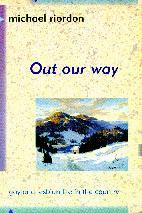
Out? Our way? Michael Riordon's look at rural lesbians & gay men -- many isolated, lonely, & deep in the closet. |
Hoping to honour rural gay lives, Michael Riordon seems instead to have offered a compelling case for living smack at Church & Wellesley.
I know: "We are everywhere." That slogan of the gay movement had point: homosexuality is everywhere. But distinct gay perceptions of the world, born of shared culture and community -- they are not. Except as they are imported from cities.
In 1987 Michael Riordon and his lover Brian decided to escape the city, moving to a small house on a dirt road far up a hill in rural Prince Edward County. Michael later wrote:
- We've moved from being quite out to being quite discrete. It's an odd sensation, like starting over from scratch. The neighbours who help us haul our firewood know us as a couple, or as good as. But we never actually say The Word. ... We've deliberately chosen a place out of sight from any neighbour's view.
Nonetheless, Michael was enthralled with rural life -- and curious about how other gay people might deal with it. He decided to find out, and write about it. Through "a paperstorm of notices, letters and ads in gay, lesbian and mainstream publications" he made many contacts; in a year of travel he talked with about 300 people.
Among them were Jane Rule and Helen Sonthoff, on Galiano. When Michael's book, Out Our Way: Gay and Lesbian Life in the Country came out in 1996, Jane sent me a copy. I sent her thanks -- and a critique.
- To my surprise, given it's Michael, I found myself disappointed, even occasionally irritated. How many times do we have to hear "I always knew I was different"? I find tales of oppression, per se, boring: sad whines finally pathetic unless they lead to some more active awareness or resistance -- which for me and I know for you, involves some sense of connection, community.
The only stories I found interesting were the ones about people who, despite the challenges of rural distance, had managed to connect with other lesbians and gay men -- and out of something more than a longing for "that one, special person."
Many of the people Michael found were isolated, lonely, and very much not out. Most had had some experience of gay life in cities; the most resourceful used skills learned there to build connections, communities spread over vast areas, people coming together from hundreds of miles around for parties, picnics, and dances.
Some regularly fled to the city. Others imported urban gay life: a surprising number (including my friend of the early '70s, Joey Shulman) ran guest houses, often hosting hordes of homos.
Others were in touch with gay groups in cities, read gay mags produced in cities. (The last and perhaps only one published in the countryside, from various US locales, was RFD, born in 1974 but gone before Michael did his interviews.)
The few not so connected (even some who were) told of lives full of fear, pathos -- and longing, that "one special person" a species rather thin on the ground out in the country. A few couldn't wait to get out -- to the city.
On the first page of Out Our Way, Michael said he wrote it for three audiences: gay people who choose to live rural lives; urban homos who can't imagine why they would ("Are you out of your mind?"); and people not gay who, while not "actively bent on doing us harm, ... just don't know any better."
An eye to that last audience may suggest why Michael indeed seemed to be "starting over from scratch." Many (if clearly not all) of the stories he told might easily have appeared in A Not So Gay World in 1972, meant for those who didn't "know any better" then. As I said to Jane:
- So he will explain us to them, justify our lives to them -- through our suffering, our isolation, our sad, brave nobility. It's a motive I find pathetic and -- hardly to coin a phrase -- self oppressive: that justification is always on someone else's terms, however different our own terms may be (even among ourselves!).
Michael had, I told Jane, "written a compelling argument for living smack dab at Church & Wellesley" -- where, as Neil Bartlett said of The Bar, "you didn't have to explain anything to anyone who was there, not anyone."
***
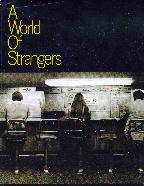
Setting a margin of safety: Lyn Lofland explores the city as A World of Strangers, 1973. |
For gay men -- & for more lesbians than most people might think -- the world of strangers can be paradise, crowds a rich, entrancing sea.
Michael counted as "rural" "places where we lack the critical mass of our urban cousins." The happiest of his rural cousins were those who, with some effort, had found a critical mass of other gay people, a small one perhaps, but sufficient.
Cities are defined -- economically, socially, culturally -- by critical mass, even its massive excess. But they offer more than people in great numbers. They offer people we don't know. Most we never will. But others....
The city is, as sociologist Lyn Lofland titled her 1973 study, A World of Strangers. She made it plain that, in evolutionary terms, this is truly odd. For most of our time on the planet, human beings rarely saw anyone they didn't already know. The appearance of strangers was so unusual it called for special rituals -- a common one, to kill them.
We have come to live among hordes of strangers, coping with them every day only by learning distinct skills. Many have to do with creating our own personal, private sphere of space even as we move in a crowd. Lofland (whose book is subtitled Order and Action in Urban Public Space) lists some techniques: minimizing expressivity, body contact, even eye contact; reacting to dubious situations with disattention, even flight.
She says of the skilled urbanite (defined as male, public space historically A World of Men):
- He moves through public space in such a way as to make himself as inconspicuous as possible, while simultaneously communicating to anyone who might happen to look that he is definitely not open to interaction.
From this, she says, comes the common reputation of cities as "cold, unfriendly, cruel, inhospitable," noting the irony that "a device for 'avoiding' the city should come to be seen as capturing its very essence."
***
Cities are dangerous -- or so we're told, mostly by the mass media. Most local TV news shows gladly play press agent to the police -- who want us to live in fear and demand their protection. Paranoia is a great booster of police budgets.
Women, especially, walk city streets in mortal terror -- we're told; as they're told they should. In fact it's largely an urban myth, as a stroll down any busy sidewalk will prove. Most people, women included, are not on the lookout for danger, wary of the urban throng. Most often, they are oblivious to it.
I walk quickly, behind women self consciously: I don't want to seem a threat. I try to get past them as soon as I can. In all those passes, almost none has shown even the slightest awareness that I was closing in behind.
I can't recall how often I've nearly run over people, most of them women, wandering out of stores without a glance around, even stepping out backwards. They're not afraid. Sensibly not: busy streets are safe -- precisely because they are busy.
There are more willful brands of urban obliviousness. Lofland noted how people "privatize" public space -- often by bringing their private world out with them. Sociologists like to cite kids travelling in "packs," I suspect because we're supposed to fear juvenile gangs. I more often see people do it in duos, or trios, friends making everyone else mere scenery, if seen at all.
Some visibly alone do it by electronic proxy, cell phones clasped to their heads, their end of the exchange blared out as if of vital interest to all within earshot. So chic, so now -- so self important; in fact a whole new breed of urban illiterates.
No group does it better than a nuclear family, or any extension thereof, particularly if the kids are along. They're rarely inconspicuous. They "avoid" the urban swirl by taking over the turf as if no one else were there: hailing each other across crowded stores; kids throwing tantrums, parents reining them in -- all as if they were at home in the rec room.
***
The ultimate private space taken into the public world is the car. As Alex Wilson wrote in The Culture of Nature:
- It's hard to imagine a technology that better discourages communal activity and an egalitarian experience of the non- human world. After all, the private car and the nuclear family have a parallel history. They are both founded on acts of exclusion. Within is radically different from without. The family and the car -- and the family car -- are bounded entities that discourage unregulated exchange.
Alex was talking about auto excursions into the "natural," non- human world. But the automobile is also firm defence against "communal activity and an egalitarian experience" of the all too human world of the city. To people in cars streets are not places, they're routes; the people out there aren't people but "pedestrians" always in the way, on a bad day maybe roadkill.
It's no surprise that the latest lightning rod for middle class angst over the dangers of downtown is squeegee kids. They rush in on that most sacred shell of privacy in public space, the car. They touch it, they get it wet; heaven knows where that filthy squeegee (or those hands!) have been.
Squeegee kids are urban contagion epitomized.
***
You'll have gathered I'm not fond of people moving through a city and trying to avoid it.
The invaders I actively resent: the turf they claim, after all, is my own -- not privately, but proprietorially: these streets are home. Like any home, they are worthy of respect.
The carefully "inconspicuous" one can hardly resent: city streets can overload the senses; sometimes one has to say, no, not right now. But I can feel sorry for those who make it a habit: they miss so much. The city is wondrous, worthy of attention. And care.
Some of us pay close attention indeed as we move through the world of strangers, on the lookout less for danger (though it can be there) than for opportunity.
For gay men (and for more lesbians than many people think) a world of strangers can seem a paradise -- of serendipity, surprising finds, random pleasures and, of course, potential sex. Our ambient eroticism, not limited to "private" spaces, makes strangers not a threat, but an attraction. We are natural xenophiles. A crowd can be a rich, entrancing sea.
***
Cities, we're told, are "anonymous." It's not entirely true: urban people know lots of other people, by name and some very well. But very often we move among people who don't know who we are.
To anyone (like me) who grew up in a town where everyone knew whose child and even grandchild one was, it can be liberating. In the city we can choose who we want to be, at least in the moment. We can play with our identity, even try on new ones.
Cities are varied, polyglot -- Toronto especially, this once grey Anglo town now among the most culturally and linguistically diverse cities in the world. Writer Alberto Manguel, like so many of us here an immigrant, has said:
- Because of its lack of imaginary weight [as compared to Paris, Venice, Montreal] Toronto is a place that you must reconstruct on your own, without the help of universal cartographies. That is why there is an almost infinite number of Torontos.
And an infinite number of ways to live one's life here.
Cities are aggregate: great mosaics of scenes, spaces, centres, margins, mysteries -- any of which may suit you, marginal spaces maybe best of all.
***
All we need allow each other is some space & a bit of civil courtesy. Cities let us do that.
Cities are tolerant. They have to be; were they not, the term "civil unrest" would take on daily meaning. We can't really avoid each other; we must, at least, put up with each other. Only in a very small town can those out of favour be "run out of town."
To the gay movement, "tolerance" was not enough, almost a dirty word. We demanded "acceptance."
What infantile whining that can seem to me now: Accept me! Embrace me! Love me! (Me, me, me, it's all about me.) In our eagerness to be accepted, too many of us tried to be "acceptable," "respectable" in someone else's eyes.
What impulse so makes us crave others' approval? "Infantile" may be dead on: babies know only their own feelings, no one else's, and they need others to care for them. For many gay people this demand for acceptance was a cry to the Great Unresolved Family: it's only human to want Mum and Dad to love you.
But few fellow citizens are Family, even in places (like the AIDS Committee, as I too well recall) where they might think they ought to be. We don't need to love each other to share a city. We don't even need to like each other, certainly not to approve of everything in each others' lives.
We can't legislate acceptance, can't force other people to approve of us. But we can legislate tolerance: others must, at the very least, let us be and not do us harm.
All we need allow each other is some space, and a modicum of civil courtesy. Cities let us do that. Their mere "tolerance" -- and their diversity, vitality, their sheer mad randomness -- is what makes gay life possible.
As that old local ghetto jokes goes: "When I go north of Bloor I need oxygen."
***
|
Rainbow Country!
|
Church St is not just gay, but "Gay," a parody of itself.
We like replicas over reality, "places" over places, because they're safely under control. The potential mess & threat
of the real have been swept
out of sight.
South of Bloor (which isn't far north), we've found in this town critical mass, mutual attention, anonymity turned connection, and tolerance created by our simple presence in great number. We have made it gay downtown.
Church & Wellesley is (as Robert Fulford called all of Toronto), an "accidental city" -- or "village" if you insist -- created by flukes of real estate, high rise development, cheap rent and, just in time, zoning to preserve a living street. On, and only on, that base did we then build a community, or a geographical locus for one.
The neighbourhood, long nondescript, now positively screams gay -- in, of course, all the colours of the rainbow. Flags abound: Canadian Rainbows, American Rainbows, Rainbows on their own. Store windows, displays, a billboard painted on a wall above The Village Rainbow -- all Rainbows.
All this is a bit loud even for some veteran gay activists. Once wandering through it all, in town from Halifax, Robin Metcalfe found himself thinking: "Do you have to be so... gay?"
His reaction surprised even himself, Robin long quite gay: openly, visibly, even blatantly.
I suggested what he might have felt was: Does it have to be such a cliché? Do you have to be so predictably banal about being gay? As if people might not get it if it weren't so obviously labelled?
Well, yes: if you've decided the place is not a neighbourhood but a theme park. Disneyland is full of signs reminding you you're in Disneyland.
***
Church Street has become not just gay -- but "Gay." As a destination with something distinctive to offer, it can't simply be a place. It must become a "place," a promotable attraction easy to identify.
That identity must be obvious, its symbols instantly recognizable. In time the symbols come to stand for reality, a place no longer itself but "itself" -- a parody.
In Julian Barnes's wonderful 1998 novel, England, England, a corporate magnate buys the Isle of Wight and turns it into a theme park of England, replicas of all the requisite tourist sites in easy proximity. It's not England, but England, England -- much more convenient than the real thing, as a promo package notes:
- In out time-strapped age, surely it makes sense to be able to visit Stonehenge and Anne Hathaway's Cottage in the same morning, take in a 'ploughman's lunch' atop the White Cliffs of Dover, before passing a leisurely afternoon at the Harrods emporium inside the Tower of London (Beefeaters push your shopping trolley for you!)
Even the royals of the day see its value (for their own PR; they're having "image" problems), moving into its ersatz Buckingham Palace to become part of the show. A French theorist advising on the project explains its appeal.
- It is well established that nowadays we prefer the replica to the original. ... Now, the question is to be asked, why is it we prefer the replica to the original? Why does it give us the greater frisson?
To understand this we must understand and confront insecurity, our existential indecision, the profound atavistic fear we experience when we are face to face with the original. We have nowhere to hide when we are presented with an alternate reality to our own, a reality which appears more powerful and therefore threatens us.
Once there was only the world. Now there is the representation -- let me fracture the word, the re- presentation -- of the world ... We must demand the replica, since the reality, the truth, the authenticity of the replica is the one we can possess, colonize, reorder, find jouissance in, and, finally, if and when we decide, it is the reality which, since it is our destiny, we may meet, confront, and destroy.
Barnes was having a bit of fun, parodying an intellectual going on about parody. But the point was his own, and his book's: we like replicas over reality, "places" over places, because they are safely under control.
Nothing is messy, threatening, intimidating -- because nothing is real. "Ye Olde" has replaced the truly old, likely demolished as "inefficient." Handicrafts stand in for historic artifacts: cute, even "interesting" -- but devoid of anything mysterious, unknowable, perhaps even sacred.
No one put it better than Holiday Inn: "The best surprise is no surprise" -- no matter where in the world you might be.
***
Holiday Inns are for tourists, their "exotic" adventures guaranteed safe. They want the gleaming Caribbean beach, not the hovels likely hidden behind. They want to be catered to; they don't want to know how the catering happens -- or who their caterers might really be.
Actual theme parks notoriously hide their inner workings; at Florida's Disney World they're all underground -- just as they were in classic dystopian visions on film: Ridley Scott's Blade Runner; Fritz Lang's Metropolis. Not just works but workers are invisible -- except as they're there, trained right down to the mechanical smile, to cater to your every need.
In The Culture of Nature, Alex Wilson drove the Blue Ridge Parkway, designed to enhance tourists' "view from the road."
- To the planners, some land adjoining the Parkway was decidedly not a pretty picture, especially the shacks and worn out farms of hillbillies -- an outsider's term for the impoverished whites of the southern Appalachians. In some cases, these people were moved elsewhere, out of sight. ...
In the early 1960s, "Hillbilly Shows" were performed for tourists on the edges of the road. Men in crooked hats and women in long flowered dresses with holes in them played music and demonstrated whisky stills and other putative trappings of a culture in dissolution.
Where productive working economies have been replaced by the economics of tourism, local inhabitants become "local colour," hired to parody what was once real life. Or they are "moved elsewhere, out of sight."
***
|
Ghetto? Village?
|
Domestic goods, high bulk & low margin, barely cover soaring retail rents. Small, profitable tourist toys can. On Church, more & more, they do.
Church Street, increasingly, is for tourists, a theme park for the ever touted "gay market."
Few local residents share in the fabled affluence of that "market." Data from the 1996 census for Tract 63 (Bloor to Carlton, Yonge to Jarvis) show more middle income people than on average across the metropolis, few deeply poor, fewer still very rich.
Just 7.2 percent of men in the area, 4.5 percent of women, earn more than $60,000 a year. More than half the women, 42 percent of men, live on annual incomes of less than $20,000.
This is a market unlikely to sustain the raft of bars, restaurants, galleries and gift shops that line Church Street. And it doesn't. More and more, tourists do.
By "tourists" I don't mean gay people from nearby, though the ones from Cabbagetown a few blocks east do tend to be better off. But, you'll note, all those bars, restaurant and other attractions are not on Parliament, their own main drag. They're on Church.
Church is near the subway: easy access for those beyond strolling distance. From further reaches of the central city, the suburbs, the exurbs; from Union Station, Pearson International, attracted by promo for Toronto's gay scene, sports tournaments, Pride fests as big as (maybe bigger than) anywhere -- in they flock. To Church Street.
And to visible impact on Church Street. Its storefronts (bars and restaurants aside) are filled more and more with thcotchkes, tinsel, art, gifts, leather wear, sex toys; less with groceries, hardware, housewares, paint.
Locals, of course, might buy leather, gifts, art or toys, just as tourists will. But tourists don't buy groceries, light bulbs or toilet paper. Domestic staples are high bulk, low margin; they barely pay for their floor space -- and retail rents are soaring. Tourists trinkets are small and profitable. They can pay the rent.
Increasingly they do, as do rivers of beer, tankloads of martinis, tons of pasta, sun dried tomatoes and shitake mushrooms. Sure, locals go out, but they're not the ones downing all that every day. Most can't afford to.
***
A summer Saturday on Church is a swarm of casually (if carefully) dressed Guppie couples and aging clones gone a bit broad at the beam, moving at the speed of gawkers on a midway or settling in for a $5 latte at Starbucks.
Here can be seen what I've come to call The Homosexual Face. The jaw is pulled down, the mouth in a pout, the nose drawn down to a snoot to suit the snooty gaze of eyes near dead with disdain. Waiters see it all the time.
My characterization is, I admit, unfair. This is a long face long seen: 18th century caricaturists captured it famously. It's the look of the wary arriviste, certain that the service he's getting -- not to mention the people providing it -- are not quite up to snuff.
It's the look of people at once pretentious and stupid. I quess I find it particularly irritating on the faces of fags. (It seems more rare on dykes. But on Church, dykes are more rare generally.)
We locals, many of us, are servants, "local colour." We don't do Hillbilly Shows, but can pull off the Bartenders' Boogie and the Waiters' Waltz like the pros we truly are.
***
Well, why not? Are poverty & homelessness "gay issues"?
Well, it is all rather a show and not so bad, really. It does pay the bills, even if it doesn't pay us, or our place, true attention.
We can see that when "local colour" gets a little too colourful for comfort. Panhandlers and squeegee kids weren't in the brochure. Gay entrepreneurs, even many ordinary gay people, wish they weren't on our streets, either.
During the spring of 1999 Xtra ran a spate of letters complaining of, as one put it, "an infestation of beggars, squeegee kids and pushers" in the area. "They destroy the wonderful atmosphere and peacefulness which makes this community so special and they scare away business."
Even worse: "Their presence causes our more sensitive members to move elsewhere because they now feel vulnerable in their own community. We want them out." More than tourists could want a polite, carefully controlled theme park.
Xtra reported on November 4, 1999 that "business owners in Vancouver's gay neighbourhood want to push panhandlers right out." The Davie Street Business Improvement Association had done a brochure. "We know that most people on the street suffer from drug or alcohol addictions," it read. "Your loose change only feeds their addictions. Don't be fooled by signs saying they want food and shelter."
"Those who work with street youth are disappointed," the story said, to see this tactic applied "by an association spearheaded by gay businesses." Well, why not? Are poverty and homelessness "gay issues"?
Well, maybe -- if the poor and homeless are homos. In its next issue Xtra reported a study by Toronto's Shout clinic, saying that "about 1,000 gay kids sleep on the streets every night."
The report didn't contain "many specifics on Toronto's queer homeless youth," Xtra said, but of all the street kids it surveyed, 31 percent had tried to make money in sex work, 36 percent squeegeeing or panhandling.
Eighty five percent said they hoped to find a job. They might have better luck with that, tough as the job market is for kids, than in finding a place to live.
***
|
Condomania
|
Castro.com
From Kirk Read's "Running from the streets of San Francisco" (in fab, Aug 17, 2000), on homos getting squeezed out of the world's most famous -- & high rent -- gay mecca:
"People in their 20s are either working in dot.companies or splitting egregious one bedroom rents with four other people. If you're wondering why there are so many 'Help Wanted' signs in the Castro, it's because $8-10 an hour doesn't pay rent anymore. The green haired kids who serve pizza by the slice are being pushed out of the city that has for decades been a queer mecca.
"The thing is, those green haired kids are often the people who, in their spare time, organize poetry series, club nights, and activist movements. The saddest irony here is that the people getting squeezed out are often the ones who make the city so desirable in the first place.
"My dot.com friends are working so many hours that they don't have time to participate in the city's cultural scene, let alone play a hand in creating it. ...
"Dozens of years of struggle by us homosexuals has basically amounted to a strip mall where tourists can hold hands and buy rainbow trinkets.
"San Francisco is over. Now that's a reason to be proud."
Click here for the full text of San Francisco is Over, as it's titled on Kirk Read's website.
(http://www.temenos.net/kirkread).
(Much) more
on Church & Wellesley
For details on how Toronto's gay nabe came to be, with data on demographics, 1951 to 1991, & on the high rise apartment boom that long made it an affordable haven for young single people, see More on Church & Wellesley on the CGLA site.
The forces that shaped Church & Wellesley were largely economic ones. The economy rolls on. What God the Market giveth, God may taketh away. And likely will.
The key defining element in creation of the neighbourhood, its true sine qua non, was lots of small apartments that young people, just making a start at life in the city, could afford.
They are no more. The units are still there; their current tenants can still afford them, if barely and maybe not for long. But newcomers are out of luck entirely.
One of the Tories' first moves was to abolish rent controls that had been in place for years. Existing tenants still pay controlled rents, but as soon as a place is vacant the landlord can charge whatever the market might bear.
This offers incentive to create vacancies -- through evictions. And, under new Tory rules, evictions are harder than ever to appeal.
Even those paying reasonable rents can now be stuck with charges for major "capital improvements." The neighbourhood rings with jackhammers, the crumbling concrete of '60s vintage balconies under sudden, roaring renovation.
The improvements these tenants pay for may in fact speed their eviction (if the noise doesn't effect it voluntarily): what they most improve is a building's value for sale -- as a "condo conversion."
The Tories' stated motive (the true one, as ever, to line already rich pockets) was to "create incentives" for construction of rental apartments. Almost none had gone up anywhere in the city since the early '80s. And since those "incentives"? None still.
There has been lots of residential construction. Until 1995 much of it was cooperative housing, or designated low income units like the one I live in now, most built with financial support from the province. Under the Tories that's over: We're not in the housing business, they said. The federal government had said the same thing in 1993.
If you see a construction site these days, you can be sure it will sprout a condominium. Church & Wellesley had few (in fact I think none) before the early '80s; now it has quite a few. Some are office conversions; one at Church and Alexander is glaringly new, if of mediocre design, replacing The Village Green's once very cruisy garage.
Life at that corner, alas, will never be the same.
***
The life of the whole neighbourhood likely won't be the same for long. Its other defining factor was control of all that high rise development in time to save a street rich in the amenities of daily urban life.
I don't like calling it "The Village"; the term smells of whitewash. But in feel, use, everyday life, it can feel a village. It may not for long: village merchants -- particularly those catering to village residents -- are feeling the rent squeeze, too.
In 1997, San Francisco's KQED looked at local neighbourhoods, one episode on the Castro District -- that quintessential gay ghetto. A friend sent it to me on tape.
I watched warily at first, suspecting the usual American homo promo: clean, earnest, and (as we liked to say at The Body Politic) "lacking analysis." Its opening, a tour group led by a nice grey haired lesbian elder, rainbow decked, made me think I'd be right.
I wasn't. It was an absorbing history, showing how that working class district had become Gay Mecca. That tour guide at the beginning became a foil for the point made at the end: the Castro is now for tourists; as the narrator says: "a gay theme park."
The people who created it can't afford to live there anymore.
***
If we are priced out of our own little Gay Mecca, where, I sometimes wonder, will we go? Where is Toronto's next Church & Wellesley?
College Street? That evolving Little Italy? The rise of gay (or gay friendly) bars and clubs there may seem a hopeful sign, but those, too, depend mostly on tourists, not on a big local base of gay residents. Leslieville, way out on Queen East? Or Queen way west, in Parkdale? They're looking hopeful, too. In any case it will have to be someplace cheap, even marginal. That's how we started out.
But maybe it won't be anywhere at all. Maybe the forces that created our nabe simply won't come into play again anyplace else -- at least not in the ways we've known them. Maybe, we won't need them to.
Maybe we'll come to know an entirely different life.
Go on to Part Eight: 2000 And now?
Go back to: Contents page / My Home Page
This page: http://www.rbebout.com/bar/citizen2.htm
January 2000 / Last revised: August 21, 2002
Rick Bébout © 2002 / rick@rbebout.com
